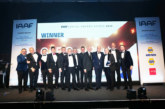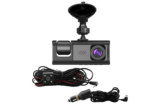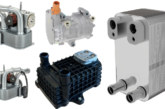Engine coolants – what about colour?
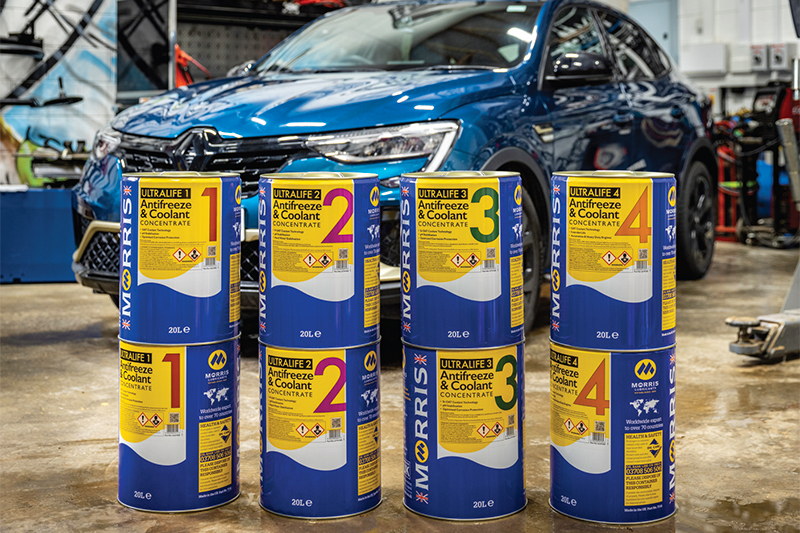
What does the colour of antifreeze coolants mean? Morris Lubricants Technology Manager, Adrian Hill, explains all.
Blue, red, violet, orange, green, all the colours of the rainbow, but which one of these antifreeze coolants is the right one for the engine in question? The quick answer is, forget the colour, think: “Which specification is correct and demanded by the vehicle’s OEM?”
So why were dyes introduced to antifreeze coolants in the first place? Apart from some specialties, antifreeze coolants are based on Monoethylene Glycol – or MEG for short – which is virtually colourless. So, when mixed with water, you couldn’t really tell the difference, which is why dye was introduced as a visual indicator. This is the only reason we have all these different colours. They do not enhance or provide any performance benefits, which is why when choosing an antifreeze coolant, specifications should always be prioritised. The specification or performance level requires balanced chemistry to ensure maximum system and component protection.
So now that colour has been demystified, what are the other features and benefits of an antifreeze coolant?
Temperature control
Engine antifreeze coolants are never used neat and are always diluted with water – deionised, distilled or demineralised water are needed before use. The optimised mixture is 50% antifreeze coolant and 50% water by volume.
In its concentrated form, an engine antifreeze coolant, as previously mentioned, consists mainly of MEG. The presence of MEG at low temperatures disrupts the formation of ice crystals. This is important, as ice is less dense than water and takes up a greater volume. This is where damage can occur, and the formation of ice can crack heads, damage head gaskets or split pipes.
However, MEG on its own is not very good at carrying heat away from the hot parts of the engine, and this is why it needs to be mixed with water. Water cools extremely effectively. But, when the engine reaches running temperature, the heat around the combustion chamber climbs rapidly and the temperature starts to exceed the boiling point of water, which is 100°C. Most engine coolant systems are sealed and operate under increased pressure, which can elevate the boiling point of water so that it boils higher than 100°C. As this temperature rises and to stop the antifreeze coolant from boiling, MEG has another job to do. MEG increases the boiling point of water, and at 50% solution mix, it can push it as high as 108°C.
Engine overheating becomes a potential reality, particularly in the summer months, where ambient temperatures will be seasonally higher. Factor into that heavy, slow moving traffic conditions, where air flow through the radiator is minimal and the engine is relying on an electronic fan to assist, overheating needs to be avoided at all costs. This is when the engine antifreeze coolant earns its medals and helps to manage any heat excess and remove the likelihood of damage occurring.
MEG helps the antifreeze coolant from freezing at low temperatures and prevents it from boiling at high temperatures.
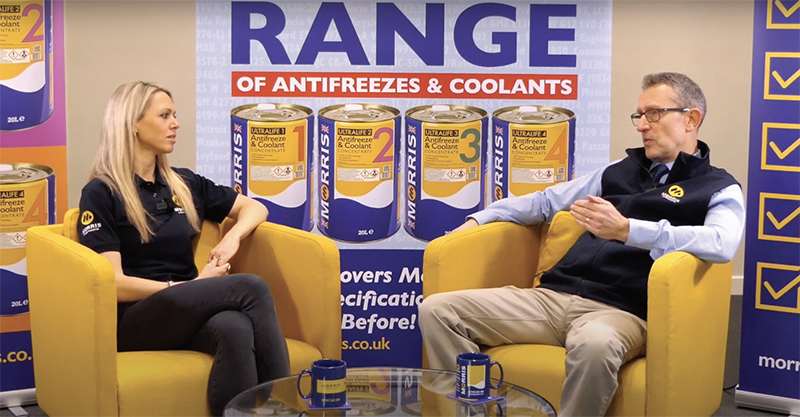
Inhibitors
Of course, weather conditions – hot or cold – traffic conditions – standstill or cruising – are only part of the challenge. Another important function of an antifreeze coolant is to prevent any metallic components in the system from rusting or corroding. As I have already said, water excels at cooling, but it has a detrimental effect on metals, particularly at elevated temperatures. This is where essential extra chemistry is required, referred to as the inhibitor package.
The inhibitor package is a combination of different types of chemical compounds that are designed to give varying degrees of protection and may even be used to target more sensitive metals, such as aluminium in certain water pumps, for example. You may see the type of chemistry used referred to as inorganic or organic depending on the family of compounds used and the type of protection the antifreeze coolant is designed to offer.
In general, inorganic acid technology (IAT) is extremely active and will seek out all materials in the system, whether susceptible to rusting/corrosion or not. Because it is very active and doesn’t discriminate, it becomes depleted after around two years and the antifreeze coolant solution should be changed.
An alternative is organic acid technology (OAT) that only targets materials in the system that start to show signs of rusting/corrosion. This type of inhibitor system is selective and, as such, does not become depleted as quickly and can be left in the cooling system for up to five years.
Some OEMs may require a combination of these technologies, and ‘hybrid’ antifreeze coolants are available for specific engine designs. These may be referred to as P-OAT (phosphorous containing), or SI-OAT (silicate containing).
The good news is that all these technologies are covered by our range of antifreeze coolants!
Other additives
In addition to the inhibitor package, other components may be added to improve the antifreeze coolant’s performance. Stabilisers are used to stop the inhibitor additives from separating, as well as compounds to prevent hard water deposits, pH buffering agents to maintain an optimum pH level and antifoam additives to get the antifreeze coolant right and working well. It is a balancing act between engine metallurgies and the antifreeze coolant’s chemical formulations. Remember it has nothing to do with colour of the product!
Final word
Engine antifreeze coolants perform in the engine all year round and do not just cover the winter months when the weather gets cold or in the summer months when the temperature is hot. The correct antifreeze coolant mixture ensures maximum operational efficiency when the engine is running, preventing damage and ensuring the integrity of the system components.
Antifreeze coolant choice should be made based on the engine manufacturer’s requirements and not colour. If there is any doubt as to which antifreeze coolant is required, motorists should check with the manufacturer or seek independent technical advice.
With 171 engine manufacturer specifications and international standards, using OAT, PSi-OAT, P-OAT IAT and MEG technologies, our antifreeze coolant range covers all bases.
The recommended antifreeze coolant can be found on Morris Lubricants’ Whatoil online tool, while product information can be looked up on its website or call our dedicated Technical Services Team on 01743 237541 or speak to the sales team on 01743 232 200.
On our YouTube channel, there is a video series that explains more about our range of antifreeze coolants.



